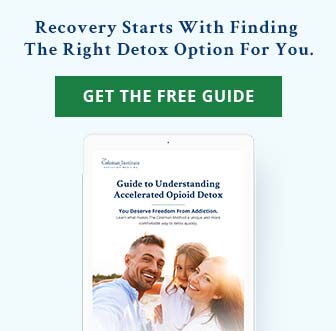
Naltrexone Therapy for Opiates FAQs
- What is Naltrexone therapy, and why is it important for opiate addiction?
- Does Naltrexone therapy have any risks and side effects?
- How long should I be on Naltrexone therapy?
- What is the risk of overdosing following treatment?
1. What is Naltrexone therapy, and why is it important for opiate addiction?
Our ultimate goal with Accelerated Opiate Detox (AOD) is for patients to begin a life of abstinence — rather than treating addiction with a maintenance program that uses other opiates, such as Suboxone or methadone. We recognize that recovery is a challenging path to walk, filled with many opportunities for relapse. So, after AOD, we use Naltrexone therapy to help patients focus on their psychological healing without the temptations to use again.
Naltrexone is a non-addictive, non-narcotic medicine that attaches to the brain’s opiate receptors and completely blocks them. As a result, patients feel no effect from opiates while on Naltrexone and experience virtually no drug cravings.
We believe that 12 months of Naltrexone therapy gives patients the best chance for lasting recovery. This support allows their brain to physically heal from the opiates’ damage while they build the psychological tools and strength they need to remain in recovery.
2. Does Naltrexone therapy have any risks and side effects?
As with any medical procedure, Naltrexone therapy carries some risks and potential problems. While small and typically painless, the Naltrexone implant does require local anesthesia for insertion. As a result, some patients experience the following symptoms at the implant site:
- Irritation
- Inflammation
- Infection
In addition to these implant risks, Naltrexone therapy can cause withdrawal symptoms if a patient isn’t fully detoxed when treatment begins. To avoid these risks, we carefully monitor patients before beginning Naltrexone therapy and only start treatment when they have completed their Accelerated Opiate Detox.
3. How long should I be on Naltrexone therapy?
We strongly believe that patients should be on Naltrexone therapy for at least 12 months after completing their detox. Recent research shows that it takes a year or more for the brain to fully heal from addiction. And we know that it also takes at least a year for people to learn about alcoholism and recovery, build up a support system, and integrate all of the recovery changes into their lives. Having Naltrexone therapy during the first stages of recovery helps reduce the risk of relapse in patients while giving them time to invest in their long-term health.
4. What is the risk of overdosing following treatment?
Accelerated Opiate Detox clears patients’ brains of all opiates, which means they are clean — but they also have no built-up tolerance for the substance anymore. We have all patients use Naltrexone therapy immediately following their detox to reduce cravings and provide some overdose protection if they do relapse. However, patients must know that when Naltrexone therapy ends, they will have a very low tolerance to any opiates. As a result, if they relapse, a dose that would have gotten them high before detox can be fatal after treatment.
Very rarely, patients may try to override their Naltrexone therapy and take a very large opiate dose in pursuit of a high. While Naltrexone is an opiate blocker that reduces the risk of most overdoses, it is possible to take enough opiates for the dose to be fatal.
Let’s Take the Next Step Together.
Have questions or want to learn more? Contact us today at 888-705-9615.


